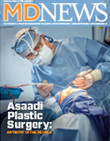New Jersey Plastic Surgeon
POSTED ON THURSDAY, MAY 15, 2014 AT 11:27 AM by Dr. Mokhtar Asaadi
 Our NJ plastic surgeon was featured in New Beauty magazine for his ability to provide the finest care to patients by seeking out the best techniques available in plastic surgery. He notes that a factor in judging his success is having patients recommend him to family & friends! To find out Dr. Asaadi’s overall philosophy and his approach to patient safety, check out the full article!
Our NJ plastic surgeon was featured in New Beauty magazine for his ability to provide the finest care to patients by seeking out the best techniques available in plastic surgery. He notes that a factor in judging his success is having patients recommend him to family & friends! To find out Dr. Asaadi’s overall philosophy and his approach to patient safety, check out the full article!
Learn more about Dr. Asaadi: NJ Plastic Surgeon
Dr. Asaadi and our staff welcome any questions you may have about plastic surgery in New Jersey. Contact our NJ office at 973.731.7000 or request your appointment online today.
Additional Links:
Facelift NJ
Tummy Tuck New Jersey
Blepharoplasty New Jersey
POSTED ON WEDNESDAY, MAY 14, 2014 AT 2:28 PM by Dr. Mokhtar Asaadi
 Dr. Mokhtar Asaadi was featured in MD News for his artistry in the details during plastic surgery. He is credited for taking his time and applying the function and concept of the entire face proportions when performing facial surgery. He reminds readers that safety is the number one priority during plastic surgery, providing the best environment to perform his work. Read the full article to learn more about Dr. Asaadi.
Dr. Mokhtar Asaadi was featured in MD News for his artistry in the details during plastic surgery. He is credited for taking his time and applying the function and concept of the entire face proportions when performing facial surgery. He reminds readers that safety is the number one priority during plastic surgery, providing the best environment to perform his work. Read the full article to learn more about Dr. Asaadi.
Learn more about Dr. Asaadi: New Jersey Plastic Surgeon
Dr. Asaadi and our staff welcome any questions you may have about plastic surgery in New Jersey. Contact our NJ office at 973.731.7000 or request your appointment online today.
Additional Links:
Facelift NJ
Blepharoplasty New Jersey
Breast Reconstruction NJ
Rhinoplasty New Jersey
POSTED ON WEDNESDAY, APRIL 09, 2014 AT 5:06 PM by Dr. Mokhtar Asaadi
Are you unhappy with puffiness, sagging, and wrinkles around your eyes? Excessive skin or swelling around the eyes can give your face an aged and tired appearance. These folds can disturb the natural contour of your face, and in severe cases, even impair your vision. Blepharoplasty, also known as cosmetic eyelid surgery, can correct these issues, giving you a younger, more alert, and refreshed appearance.
Lower Eyelid Blepharoplasty
Lower eyelid surgery is most often used to correct displaced fat pads and hollows beneath the eyes. This procedure can also correct malar bags, or severe bags known as festoons underneath your eyes. Bags and circles begin to appear under the eyes, adding age and exhaustion to your appearance. Fat pads are repositioned during this procedure fat may also be used to smooth under eye hollows, and excess skin may be removed to eliminate puffiness or bagginess around the eyes, depending on the severity of your condition.
Upper Eyelid Blepharoplasty
Heavy or puffy eyelids can cause drooping and sagging skin at the top of your eyes, giving you a look more tired, aged, and even melancholy appearance. In extreme cases, the drooping skin can extend over your eyelashes and restrict your field of vision, a condition often known as “ptosis”. Correcting ptosis is usually a medical expense covered by many insurance providers. If you’re in search of a procedure to correct your saggy eyelids, upper eyelid surgery may be right for you. By tightening muscles surrounding the eyelids and removing excess skin and fat, upper blepharoplasty surgery will give you a younger, more alert appearance and expand your visual field.
After Surgery
Patients can return home same day following eyelid surgery. Incisions after blepharoplasty surgery are unnoticeable. Sutures are restricted to an invisible incision inside the eyelid or along the eyelashes, left unseen. Swelling and bruising around the eyes can be expected to last up to a week after surgery. Your plastic surgeon will discuss the best post-op care for optimum results. Oftentimes, eyelid surgery in New Jersey is combined with a brow lift, laser skin resurfacing or even a facelift for an more youthful appearance.


Click here to check out our Before & After Gallery for more dramatic results!
Dr. Asaadi and our staff welcome any questions you may have about eyelid surgery in New Jersey. Contact our NJ office at 973.731.7000 or request your appointment online today.
Additional Links:
Blepharoplasty NJ
Facelift New Jersey
Brow Lift NJ
POSTED ON THURSDAY, MARCH 13, 2014 AT 4:43 PM by Dr. Mokhtar Asaadi
 Dr. Mokhtar Asaadi is inviting all physicians and patients who have migraines to attend a full-day plastic surgery symposium on May 2, 2014! Dr. Asaadi will be speaking as well as guest speaker recognized internationally as an authority in plastic surgery, Dr. Bahman Guyuron, to discuss using BOTOX and surgery as treatment of chronic migraines. BOTOX is FDA approved for temporary treatment of chronic migraines, and by mimicking the effects of BOTOX with surgery, Dr. Guyuron can provide a permanent solution to migraine sufferers.
Dr. Mokhtar Asaadi is inviting all physicians and patients who have migraines to attend a full-day plastic surgery symposium on May 2, 2014! Dr. Asaadi will be speaking as well as guest speaker recognized internationally as an authority in plastic surgery, Dr. Bahman Guyuron, to discuss using BOTOX and surgery as treatment of chronic migraines. BOTOX is FDA approved for temporary treatment of chronic migraines, and by mimicking the effects of BOTOX with surgery, Dr. Guyuron can provide a permanent solution to migraine sufferers.
As a cosmetic injectable, BOTOX improves the look of frown lines, crow’s feet, and wrinkles or creases in the forehead. Studies have also produced positive results when using BOTOX as a medical treatment, specifically in migraines. By relaxing surrounding muscles, BOTOX inhibits the nerves triggering headaches, giving patients up to two weeks of migraine relief. If a BOTOX treatment successfully treats your migraine, your plastic surgeon may recommend a surgical treatment as a permanent solution.
Dr. Guyuron has performed migraine surgery on over 1,000 patients with great results. The surgery, described as an adapted forehead lift, removes muscles and clips nerves, causing a “nerve decompression”. The procedure is performed as an outpatient surgery, with general anesthesia. The length of this surgery varies, requiring 45 minutes per trigger point deactivation. Patients usually notice results immediately, or in as little as four weeks. Unlike BOTOX injections, the results from nerve decompression are permanent, and do not require monthly follow-up visits.
For more information on Dr. Asaadi’s full-day plastic surgery symposium, please contact 973.731.7000.
Dr. Asaadi and our staff welcome any questions you may have about migraine surgery or BOTOX used for both cosmetic and medical purposes! Contact our New Jersey office today at 973.731.7000 or request your appointment online today!
Additional Links:
BOTOX NJ
Forehead Lift New Jersey
Facelift NJ
POSTED ON WEDNESDAY, FEBRUARY 12, 2014 AT 6:50 PM by Dr. Mokhtar Asaadi
 When considering anti-aging options and cosmetic treatments, when should you consider a more permanent cosmetic solution, such as facelift, as opposed less invasive options, like Botox or fillers? The answers lie in several contributing factors but there are a few questions you should ask yourself before choosing between less invasive facial options and a more invasive facelift.
When considering anti-aging options and cosmetic treatments, when should you consider a more permanent cosmetic solution, such as facelift, as opposed less invasive options, like Botox or fillers? The answers lie in several contributing factors but there are a few questions you should ask yourself before choosing between less invasive facial options and a more invasive facelift.
Longevity: How long will my results last and how often will I need to see my surgeon following my treatment?
Recovery Time: How long will I need to avoid physical activity? How long will I be out of work?
Personal expectations: How do I expect to look following my treatment?
Knowing and understanding the differences between cosmetic fillers and facelift surgery will help you decide which procedure is right for you.
Cosmetic Fillers:
-
Quick 15-20 minute procedure
-
Less invasive
-
Require return visits in the month-years following to keep up with treatment
-
Not permanent, but long lasting
-
May only need local anesthetic or no anesthetic at all
Facelift Surgery:
-
More invasive
-
More permanent results
-
Provides more of a drastic improvement
-
Requires more recovery time
-
Tightens underlying muscle and tissues to improve sagging and wrinkles
-
Regular treatments to maintain results are unnecessary
-
The majority of swelling and bruising should dissipate within 2-3 weeks
-
Avoid strenuous activity for the first 2 weeks
-
Most patients return to work in within 10 days
-
Involves IV sedation and stitches
Just as any other cosmetic or plastic surgery treatment, you should always consult with your board certified plastic surgeon to discuss which option is right for you. Your surgeon should listen to your concerns and establish realistic goals and expectations with you.
Dr. Asaadi and our staff welcome any questions you may have about your cosmetic options. Contact our NJ office at 973.731.7000 or request your appointment online today.
Additional Links:
BOTOX NJ
Juvederm New Jersey
Facelift NJ
Plastic Surgery New Jersey